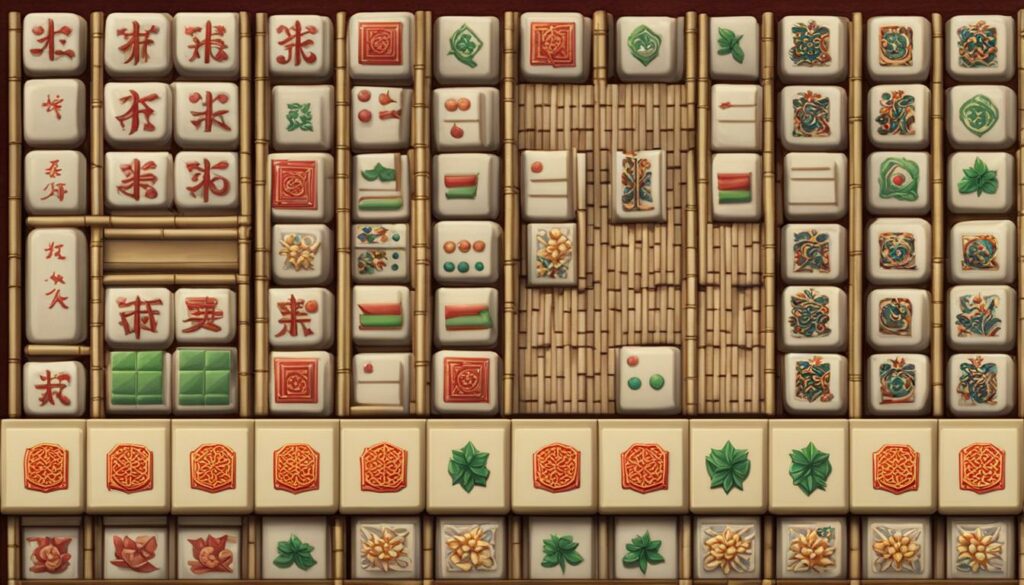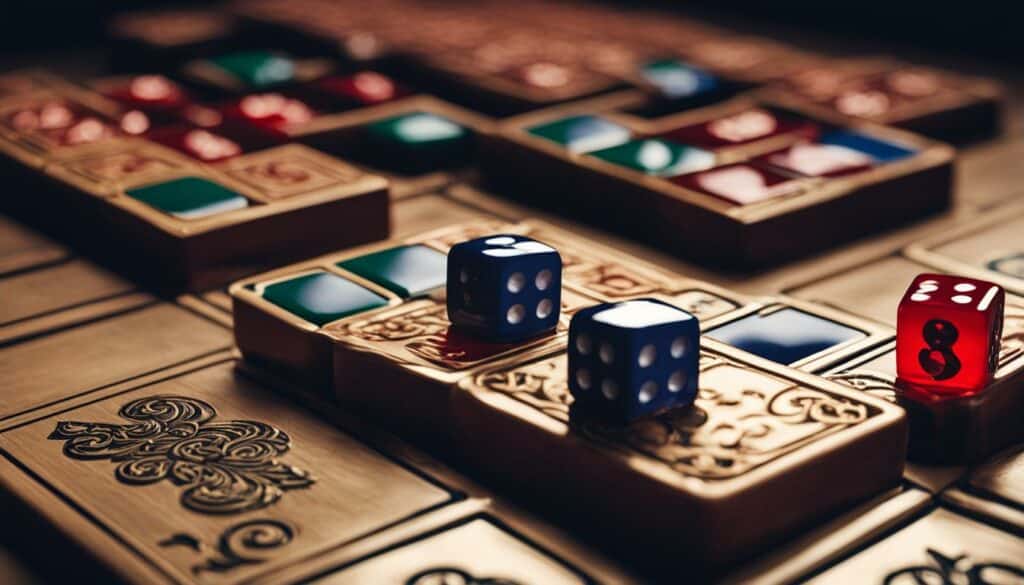Hello, fellow Mahjong enthusiasts! If you want to improve your gameplay and get an edge on your opponents, you’ve come to the right place. In this section, I will dive into the fascinating world of Mahjong and explore the essential rules and effective strategies of playing Mahjong in the Hong Kong style.
As we go along, we’ll cover everything from the game’s objective to revealing and concealing tiles, discarding and claiming tiles, scoring methods, and penalty consequences. By the end of this section, you’ll be equipped with the tools you need to elevate your skills and increase your chances of success in Mahjong.
So, let’s get started and discover the exciting world of Hong Kong Mahjong rules and winning strategies!

The objective of the Game: Creating Sets and Winning
In Mahjong, the objective is to create sets of tiles and ultimately win the game. A set can consist of three identical tiles, called a pung, four identical tiles, called a kong, or a run of three consecutive tiles, called a chow. To win, a player must have a combination of sets, which usually includes one or more pungs or kongs.
In my experience, I find that prioritizing the creation of pungs and kongs is the most effective strategy. Not only do they score higher, but they also increase your chances of completing your hand and winning the game. However, please don’t overlook the importance of forming chows, as they can be integral in completing a set and declaring mahjong.
When playing Mahjong, paying attention to the other players’ moves is essential, as they can give you crucial information about the tiles they are holding and what sets they are trying to complete. Additionally, always consider the tiles you discard and the potential sets they could complete for other players.
One strategy I like to use is to keep my options open by holding onto tiles that could potentially complete multiple sets. This allows me to adapt to the changing circumstances of the game and increases my chances of completing a set and declaring mahjong.
Understanding the game’s objective and effective strategies for creating sets is essential to succeed in Mahjong. By prioritizing pungs and kongs, keeping an eye on your opponent’s moves, and being flexible with your tile choices, you can increase your chances of winning and enjoy this exciting game to the fullest.
Revealing and Concealing Tiles: Pungs, Kongs, and Chows
As we discussed earlier, to win at Mahjong, a player must create sets of tiles that include pungs, kongs, and chows. However, it’s essential to understand the rules for revealing and concealing tiles to maximize your chances of winning.
A pung consists of three identical tiles, while a kong consists of four identical tiles. When a player creates a pung or kong, they must reveal the identical tiles to all players. This is called a revealed set.
Conversely, a chow is a run of three consecutive tiles of the same suit. When players create a chow, they do not need to reveal the tiles to other players. This is called a concealed set.
When creating a kong, one of the identical tiles is revealed, while the other three are concealed. It’s important to remember which tile is revealed to avoid making faulty claims or violating the rules of the game.
| Type of Set | Definition | Revealed or Concealed |
|---|---|---|
| Pung | Three identical tiles | Revealed |
| Kong | Four identical tiles | One tile revealed three concealed |
| Chow | Three consecutive tiles in the same suit | Concealed |
Understanding the difference between revealed and concealed sets and the rules for creating them is essential to mastering the game of Mahjong. Keeping track of the tiles you reveal and the ones you don’t is crucial to strategizing your moves and ultimately winning the game.

As players create sets, the score is tracked on a scorecard. The scorecard is divided into columns, with the total score at the bottom. Players can keep track of their progress throughout the game, and the winner is determined by the player with the highest score at the end of the game.
Bonus Scoring
Bonus points can be earned in Mahjong through various conditions, such as winning with a fully concealed hand, winning with a certain type of set, or winning with a special tile. These bonus points can significantly increase a player’s score and often make the difference between winning and losing the game.
For example, if a player wins with a fully concealed hand, they can earn an additional six points. If they win by using a special tile, such as the prevailing wind or the dragons, they can earn additional bonus points.
| Bonus | Description | Points |
|---|---|---|
| Flower Tiles | A set of flower tiles | One point each |
| Season Tiles | A set of season tiles | One point each |
| Dragon Pung/Kong | A pung or kong of dragons | Two or eight points |
| Prevailing Wind | The wind direction that is currently prevailing | Two points |
| Seat Wind | The wind direction that corresponds to the player’s seat | Two points |
By understanding both basic and bonus scoring, players can develop a more strategic gameplay to increase their chances of winning. Whether playing for fun or competing at a high level, scoring is an integral part of the Mahjong experience.
Penalty Scoring: Consequences of Rule Violations
While playing Mahjong, it’s crucial to abide by the rules to maintain fair play and avoid penalty scoring. Penalties are imposed when a player makes a false declaration or violates a game rule.
Here are some common rule violations that can result in penalty scoring:
- Exposing a concealed hand: If a player declares a concealed hand, revealing any of the concealed tiles will result in a penalty. Keeping the tiles concealed until the hand is completed and declared is essential.
- Faulty claims: If a player makes a faulty claim, such as claiming a tile for a set that is not valid or declaring a “mahjong” without a winning hand, they will be penalized.
- Declaring a false win: If a player declares a winning hand when it’s invalid or before having the appropriate tiles in hand, they will be penalized.
The penalty points will be added to the offender’s score, and they’ll also lose their turn. If a player accumulates too many penalty points, they may be disqualified from the game entirely.
It’s important to note that penalty scoring is an integral part of Mahjong, as it ensures fair play and prevents players from exploiting loopholes in the game. Therefore, it’s essential to understand and abide by the rules to avoid penalty scoring and play a successful and enjoyable game.

Conclusion
In conclusion, Mahjong is a game that requires skill, strategy, and patience. Understanding the rules of Mahjong in the Hong Kong style, including creating sets of tiles, revealing and concealing tiles, discarding and claiming tiles, and scoring methods, is essential to becoming a successful player.
Additionally, it’s crucial to maintain fair play and understand the penalty consequences for violating rules or making faulty claims. Practicing and honing your skills can elevate your gameplay experience and increase your chances of winning.
As someone who loves Mahjong, I encourage you to explore this fascinating game and discover the joy and excitement it offers. So, gather your friends and family, and let the games begin!



















